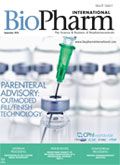Manufacturing and Distribution Boundaries Blur
Airlines, airports, freight forwarders, and other cold-chain partners are taking a crash course in pharma cGMPs.
Sieto/getty imageS

Pharmaceutical distribution was once considered separately, as a simple handoff. Manufacturers made product, then had it shipped (by a reputable company and its partners) to its destination. This approach ignored the modes and nodes, numerous product transfers, and players involved in the logistics process. It also predated biotech, and a clear understanding of just how sensitive biopharmaceuticals can be to the slightest changes in temperature, pressure, humidity, or other conditions. Today, logistics providers and pharmaceutical manufacturers agree, simple handoffs no longer work.
Good distribution practices (GDPs), which focus on optimizing conditions for product storage, have set a baseline for maintaining pharmaceutical quality and safety during shipment, transportation, and delivery.
They may all be somewhat similar and share the same goals, but every country’s GDPs are different. In the United States, the US Pharmacopeial Convention’s (USP’s) guidance is used, but the World Health Organization (WHO) has its GDPs, as does the European Union (EU), which updated its GDPs in 2013 (1).
For those cold-chain service providers farthest away from the product (i.e., airlines, airports, and freight forward and courier companies), understanding and applying pharma GDPs can be confusing (see Sidebar). Such understanding is crucial, however, especially for air cargo shipment. Temperature excursions account for $2.5-12.5 billion of pharmaceutical product loss each year, according to the International Air Transport Association (IATA), the Montreal-based trade group that represents airlines (2).
Air cargo transportation is often the riskiest portion of the product’s journey, as sensitive materials may be left waiting between flights or in various parts of airports, pending customs inspections or regulatory assessments.
“Traditionally, shippers have tried to mitigate the impact of airport delays by incorporating special features into packaging, but now we are at a point where airlines need to shore up that part of the supply chain,” says Dan Bell, Marken’s vice-president, Regulatory Compliance and Technical Affairs.
Long customs and regulatory inspection delays are still typical
One of Bell’s Big Pharma clients recently noted that Brazil’s average airport inspection time had gone down, from 70 to 60 days. But still, Bell says, “No packaging in the world can maintain product for that length of time. Airlines may need to plug in an active container or move product into cold storage or an air-conditioned room. There’s a more active part for airports to play in such scenarios,” Bell says.
There is also a strong business reason for airports to become more directly involved. Between 2000 and 2013, pharmaceuticals dropped from 17% of all air cargo shipment business to 11%, according to data developed by Pharmaceutical Commerce (2), with some pharma manufacturing centers opting for sea transport instead.
Recognizing the need for standards relevant to air shipping, IATA, which had helped develop several important airline and airport safety standards, launched the Center of Excellence for Independent Validators (CEIV) Pharma Logistics program in 2014. Its goal is to develop global standards for air transportation of pharmaceuticals, but also to certify compliant companies, and train airport, airline, product handling, and freight forward personnel in the basics of current good manufacturing practices (cGMPs) that are required to ensure pharmaceutical safety and efficacy during shipping.
IATA has been active in this area for some time, explains CEIV Pharma Logistics project lead Ronald Schaefer, with a time and temperature task force made of pharma shippers, freight forward companies, ground handlers, airlines, and airports that focuses on cold chain issues and meets twice a year. IATA’s efforts started in 2007 with the publication of its “Perishable Cargo Regulations (PCR)”(3), followed by Chapter 17, which updated guidelines for handling temperature-sensitive pharmaceuticals (4). Its next effort was to place special labels on temperature-sensitive pharmaceuticals, the use of which has been mandatory since 2012.
IATA has been engaging pharma shippers for their suggestions, given complex, varying global regulations and the number of stakeholders involved. Those in the industry agree that having standards will be crucial in the future.
In drafting a standard, IATA’s first step was studying, and adapting, the global GDPs. It focused on WHO’s and the EU GDPs as well as the EU Annex 5, but also took the best of each regional GDP and its own PCR to create one robust standard for pharma transport. The standard is designed to apply to anyone, whether they are a trucking company, ground handler, or freight forward company, says Schaefer (5).
IATA also developed two training programs, one on the operational side on how to handle pharmaceuticals, and the other on audit quality training management, a five-day classroom course. In order to receive CEIV-Pharma certification, a company must first be assessed by an independent validator who identifies areas of compliance and noncompliance and generates a gap analysis report. The company is given a chance to close the gaps, and, when it is ready, a formal audit is done, with particular emphasis on the gaps that had previously been noted. It generally takes each company about six months to become ready for certification, Schaefer says.
Training in operations and audits
In addition to the audit, companies need to complete the training requirement, by sending two people from each of its locations to the course. Certification is valid for three years, after which recertification is needed, Schaefer says.
Companies can be certified individually or collectively via a “community” approach, in which a number of different companies undergo certification together at one airport. This approach, which was first used at Brussels Airport, can be more economical, and allows different stakeholders (e.g., airlines versus shippers) to better understand each other’s challenges and needs. Since the program was launched, 34 companies have been certified, Schaefer says, and he is aiming for 80 by end of year.
Daniel says the initiative has strong precedents. After all, he asks, didn’t cGMPs result from industry-wide stakeholder agreement? “CEIV-Pharma ... is an important part of the pharmaceutical industry’s development, in establishing widespread and well-known standards for GDP, especially for entities in the distribution chain that have not developed quality systems that address GMP concerns,” he says. There will also be financial incentives for getting certification, notes Bell, because airlines, airports, and freight companies will be able to charge a premium if they can offer documentation showing improved training and quality performance.
References
1. Guidance of November 5, 2013 on Good Distribution Practices of Medicinal Products for Human Use, Official Journal of the European Union, November 23, 2013.
2. IATA, About Us, IATA.org.
3. Perishable Cargo Regulations, IATA.
4. D. Bang, “Practical and Value-Generating Approaches to IATA Chapter 17,” Seventh Edition of Perishable Cargo Regulations, Lifeconex.com.
5. R. Schaefer, “
,” March 2016.
Article Details
BioPharm International
Vol. 29, No. 9
Pages: 48–50
Citation:
When referring to this article, please cite as A. Shanley, "Manufacturing and Distribution Boundaries Blur," BioPharm International 29 (9) 2016.

Thermo Fisher Opens Advanced Therapies Collaboration Center in California
April 18th 2025The 6000-square-foot facility will provide cell therapy developers the support they need to transition to CGMP manufacturing, and an expanded footprint of the new center is expected to open in Philadelphia later in 2025.